Order of Friars Minor Capuchin
Last updated| Ordo Fratrum Minorum Capuccinorum [1] (Latin) | |
 Common Capuchin logo | |
| Formation | Founded: 1209 by St. Francis of Assisi and until the reformation aimed at regaining the original spirit of St. Francis and the Original Habit of St. Francis remained as the part of main branches. Capuchin Reformation started in 1525. [1] |
|---|---|
| Founder | St. Francis of Assisi Reformed as Capuchins by Matteo Serafini |
| Type | Mendicant Order of Pontifical Right (for men) [1] |
| Headquarters | Via Piemonte 70, Rome, Italy [1] |
Members (2020) | 10,349 (6,882 priests) [1] |
Minister General | Fr. Roberto Genuin, OFMCap |
Post-nominal initials | OFMCap |
| Website | ofmcap.org [1] |
The Order of Friars Minor Capuchin (Latin : Ordo Fratrum Minorum Capuccinorum; postnominal abbr. OFMCap) is a religious order of Franciscan friars within the Catholic Church, one of three "First Orders" that reformed from the Franciscan Friars Minor Observant (OFMObs, now OFM), the other being the Conventuals (OFMConv). Franciscans reformed as Capuchins in 1525 with the purpose of regaining the original Habit (tunic) of St. Francis of Assisi and also for returning to a stricter observance of the rule established by Francis of Assisi in 1209.
Contents
History
Origins


The Order arose in 1525 when Matteo da Bascio, an Observant Franciscan friar [2] native to the Italian region of Marche, said he had been inspired by God with the idea that the manner of life led by the friars of his day was not the one which their founder, St. Francis of Assisi, had envisaged. [2] He sought to return to the primitive way of life of solitude and penance, as practised by the founder of their Order.
His religious superiors tried to suppress these innovations [2] and Friar Matteo and his first companions were forced into hiding from Church authorities, who sought to arrest them for having abandoned their religious duties. They were given refuge by the Camaldolese monks, in gratitude for which they later adopted the hood (or cappuccio, capuche ) worn by that Order—which was the mark of a hermit in that region of Italy—and the practise of wearing a beard. The popular name of their Order originates from this feature of their religious habit.
In 1528, Friar Matteo obtained the approval of Pope Clement VII and was given permission to live as a hermit and to go about everywhere preaching to the poor. These permissions were not only for himself, but for all such as might join him in the attempt to restore the most literal observance possible of the Rule of St. Francis. Matteo and the original band were soon joined by others. Matteo and his companions were formed into a separate province, called the Hermit Friars Minor, as a branch of the Conventual Franciscans, but with a Vicar Provincial of their own, subject to the jurisdiction of the Minister General of the Conventuals. The Observants, the other branch of the Franciscan Order at that time, continued to oppose the movement.
Rules of the Order
In 1529, they had four houses and held their first General Chapter, at which their particular rules were drawn up. The eremitical idea was abandoned, but the life was to be one of extreme austerity, simplicity and poverty—in all things as near an approach to St Francis' ideals as was practicable. Neither the monasteries nor the Province should possess anything, nor were any loopholes left for evading this law. No large provision against temporal wants should be made, and the supplies in the house should never exceed what was necessary for a few days. Everything was to be obtained by begging, and the friars were not allowed even to touch money.
The communities were to be small, eight being fixed as the normal number and twelve as the limit. In furniture and clothing extreme simplicity was enjoined and the friars were discalced, required to go bare-footed—without even sandals. Like the Observants, the Capuchins wore a brown habit but of most simple form, i.e. only a tunic, with the distinctive large, pointed hood reaching to the waist attached to it, girdled by the traditional woolen cord with three knots. By visual analogy, the Capuchin monkey and the cappuccino style of coffee are both named after the shade of brown used for their habit. [3] [4] [5]
Besides the canonical choral celebration of the Divine Office, a portion of which was recited at midnight, there were two hours of private prayer daily. The fasts and disciplines were rigorous and frequent. Their main external work was preaching and spiritual ministrations among the poor. In theology the Capuchins abandoned the later Franciscan School of Scotus and returned to the earlier school of St. Bonaventure.
Early setbacks
At the outset of its history, the Capuchins underwent a series of severe blows. Two of the founders left it: Matteo Serafini of Bascio (Matteo Bassi) returning to the Observants, while his first companion, on being replaced in the office of Vicar Provincial, became so insubordinate that he had to be expelled from the Order. Even more scandalously, the third Vicar General, Bernardino Ochino, left the Catholic faith in 1543 after fleeing to Switzerland, where he was welcomed by John Calvin, became a Calvinist pastor in Zürich, and married. Years later, claims that he had written in favor of polygamy and Unitarianism caused him to be exiled from that city and he fled again, first to Poland and then to Moravia, where he died.
As a result, the whole province came under the suspicion of heretical tendencies and the Pope [ specify ] resolved to suppress it. He was dissuaded with difficulty, but the Capuchins were forbidden to preach.
Expansion
Despite earlier setbacks, the authorities were eventually satisfied as to the soundness of the general body of Capuchin friars and the permission to preach was restored. The movement then began to multiply rapidly, and by the end of the 16th century the Capuchins had spread all over the Catholic parts of Europe, so that in 1619 they were freed from their dependence on the Conventual Franciscans and became an independent Order. They are said to have had at that time 1500 houses divided into fifty provinces. They were one of the chief tools in the Catholic Counter-reformation, the aim of the order being to work among the poor, impressing the minds of the common people by the poverty and austerity of their life, and sometimes with sensationalist preaching such as their use of the supposedly possessed Marthe Brossier to arouse Paris against the Huguenots. [6]
The activities of the Capuchins were not confined to Europe. From an early date they undertook missions to non-Catholics in America, Asia and Africa, and a college was founded in Rome for the purpose of preparing their members for foreign missions. Due to this strong missionary thrust, a large number of Capuchins have suffered martyrdom over the centuries. Activity in Europe and elsewhere continued until the close of the 18th century, when the number of Capuchin friars was estimated at 31,000.
Cimitero dei Cappuccini: The Capuchin Crypt

The crypt is located just under the Church of Santa Maria della Concezione in Rome, a church commissioned by Pope Urban VIII in 1626. The pope's brother, Cardinal Antonio Barberini, who was of the Capuchin Order, in 1631 ordered the remains of thousands of Capuchin friars exhumed and transferred from the friary on the Via dei Lucchesi to the crypt. The bones were arranged along the walls in varied designs, and the friars began to bury their own dead here, as well as the bodies of poor Romans whose tomb was under the floor of the present Mass chapel. Here the Capuchins would come to pray and reflect each evening before retiring for the night.
The crypt, or ossuary, now contains the remains of 4,000 friars buried between 1500 and 1870, during which time the Roman Catholic Church permitted burial in and under churches. The underground crypt is divided into five chapels, lit only by dim natural light seeping in through cracks, and small fluorescent lamps. The crypt walls are decorated extensively with the remains, depicting various religious themes. Some of the skeletons are intact and draped with Franciscan habits, but for the most part, individual bones are used to create the elaborate ornamental designs.
What you are now, we used to be.
What we are now, you will be. [7]
Mark Twain visited the crypt in the summer of 1867, and begins Volume 2, Chapter 1, of The Innocents Abroad with five pages of his observations.
Modern era

Like all other Orders, the Capuchins suffered severely from the secularizations and revolutions of the end of the 18th century and the first half of the 19th; but they survived the strain, and during the latter part of the 19th century rapidly recovered ground. [2] At the beginning of the 20th century there were fifty provinces with some 500 friaries and 300 hospices or lesser houses; and the number of Capuchin friars, including lay brothers, was reckoned at 9,500. The Capuchins still keep up their missionary work and have some 200 missionary stations in all parts of the world—notably India, Ethiopia, and parts of the former Ottoman Empire. Though "the poorest of all Orders", it has attracted into its ranks an extraordinary number of the highest nobility and even of royalty. The celebrated Theobald Mathew, the apostle of Temperance in Ireland, was a Capuchin friar. [2]
In the Imperial Crypt, underneath the Church of the Capuchins in Vienna, over 140 members of the Habsburg dynasty are buried. The most recent burial in the crypt was in 2011 for Otto von Habsburg, the last crown prince of Austria-Hungary and eldest son of the last Austrian Emperor, the Blessed Charles of Austria.
As of June 2018 [update] , there were 10,480 Capuchins worldwide, of whom 7,070 were priests, living and working in 108 countries around the world: Africa: 1,357; South America: 1,657; North America: 664; Asia-Oceania: 2,339; Western Europe: 3,500; Central-Eastern Europe: 769. [8] In Great Britain there are currently five Capuchin friaries, and eight in Ireland.
The worldwide head of the Order, called the Minister General, is currently Friar Roberto Genuin.
India
The Capuchin order, under the leadership of Italian Capuchin priest Giuseppe Maria Bernini, took part in the European colonization of India as missionaries and founded the community of Bettiah Christians. [9] Bernini was invited by Maharaja Dhurup Singh of the Bettiah Raj, an appointment that was approved by Pope Benedict XIV on 1 May 1742. [9]
United States
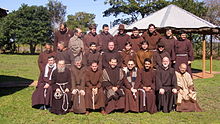
The United States has six provinces throughout the country. Together with the two provinces in Canada, the province of Australia and the Custody of the Mariana Islands/Hawaii they form the North American-Pacific Capuchin Conference (NAPCC).
Foundation
The Province of St. Joseph, originally the province of Calvary, headquartered in Detroit, Michigan, was one of the first two Capuchin Provinces to be established in the country in 1882. It was founded by Francis Haas (1826–1895) and Bonaventure Frey (1831–1912), two Swiss diocesan priests who arrived in the United States in September 1856, and were received into the then-Diocese of Milwaukee by Bishop John Henni, also a Swiss immigrant, and given charge of St. Nicholas Parish which they renamed Mount Calvary. They were later admitted to the Capuchin Order on December 2, 1857, by Antoine Gauchet of the Swiss Province who had been sent to admit them in order to establish the Order in the United States. [10] The friars started St. Lawrence Seminary High School in 1861 at Mount Calvary, Wisconsin, a school that is still owned and operated by the Capuchin Order.
One of the friars of this province, Solanus Casey, was noted for the holiness of his life, serving as the porter of several Capuchin friaries both in Michigan and New York City for decades. As a miraculous healing attributed to him was approved by Pope Francis in mid-2017, he was beatified in Detroit at Ford Field on November 18, 2017. This is significant because Casey could become the first male American-born Saint in the history of the Catholic Church. He had previously been declared Venerable in 1995 by Pope John Paul II. His tomb is in St. Bonaventure Monastery in Detroit, and is visited by thousands every year.
As of 2011 [update] , the province has 23 communities spread throughout the American Midwest, reaching from Michigan to Arizona. Additionally, there are friars of this province working in Central America, with a community serving in the Middle East. [11]
Other jurisdictions

- St. Joseph or Calvary (1882), based in Detroit, Michigan, covering the upper Midwest, from Detroit to Montana and from which came Blessed Solanus Casey.
- St. Augustine (1882), based in Pittsburgh, Pennsylvania, to which Cardinal Sean O'Malley belongs.
- Stigmata (ca. 1913), based in Union City, New Jersey, founded by friars from the Tuscan region of Italy with 8 communities on the East Coast, with friaries in Beacon, New York, Hackensack, New Jersey, Hoboken, New Jersey, Wilmington, Delaware (2), Atlanta, Georgia, and Miami, Florida.
- St. Mary of New York and New England (1952), based in White Plains, New York, with 18 fraternities on the East Coast, covering New England and New York. They supervise the Custody of Japan and the Custody of Guam.
- St. Conrad or Mid-America (1977), based in Denver, Colorado, serving Illinois, Colorado, Kansas, Missouri and Texas, with missionaries in Papua New Guinea; a friar of this province, Charles J. Chaput, was installed as the Archbishop of Philadelphia on 8 September 2011. [12]
- Our Lady of Angels (1979), Western America, based in Burlingame, California. Seven communities in California, with four communities in Mexico which became the Custody of St. Juan Diego in December 2011. [13]
- Star of the Sea Custody (1982), Hawaii and Guam, this division is dependent on St. Mary Province.
Capuchin Poor Clares
The Capuchin Poor Clares are cloistered nuns of the Order of St. Clare, who form the female branch of the Capuchin Order. They were founded in 1538 in Naples by the Venerable Maria Laurentia Longo, who was Abbess of the Poor Clare monastery of that city. She and the other nuns of that community embraced the then-new Capuchin reform movement, and so austere was the life that they were called "Sisters of Suffering". The Order soon spread to France, Spain and beyond. They live according to the same rules and regulations as the Capuchin friars, and are held as members of the friars' provinces.
In the United States, as of 2012, there are five monasteries of this Order. There are about 50 nuns in these communities, which are located in: Denver and Pueblo in Colorado, Alamo and Amarillo (the first, founded 1981) in Texas, and Wilmington, Delaware. The monasteries were almost all founded from Mexico, where there are some 1,350 Capuchin nuns in 73 monasteries. The monastery in Pueblo is a foundation of the monastery in Amarillo. Together they form the Federation of Our Lady of the Angels. [14]
Appearance
The Capuchins are unique for a Catholic religious order in that the growing of natural, untrimmed beards features as part of its first Constitution, which states as the reason, the beard is "manly, austere, natural, an imitation of Christ and the saints of our Order, and despised." This makes the Capuchin friars stand out in particular from the secular clergy of the Latin Church, who have no rule on such matters. In more recent times, since the Second Vatican Council, the beard has no longer been mandatory but is still common. Like other Franciscans, the friars wear a plain brown tunic with a hood, a cord fastened around the waist, and sandals (or shoes).
Saints and Blesseds
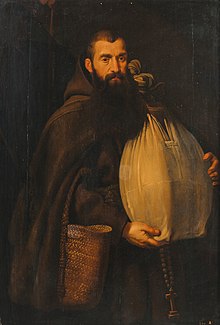


Saints
- Angelo d’Acri [15]
- Bernard of Corleone [15]
- Conrad of Parzham [16]
- Crispin of Viterbo [15]
- Fidelis of Sigmaringen [17]
- Federico da Berga & 25 Companions
- Felix of Cantalice
- Felix of Nicosia [18]
- Francis Mary of Camporossa [18]
- Joseph of Leonessa [16]
- Ignatius of Laconi [18]
- Ignatius of Santhià
- Leopoldo Mandić da Castelnuovo
- Lawrence of Brindisi
- Padre Pio of Pietrelcina
- Seraphin of Montegranaro
- Luca Antonio Falcone
Blesseds
- Anicet Kopliński
- Arsenio da Trigolo
- Benedetto da Urbino
- Bernard of Offida
- Diego José de Cádiz [16]
- Fernando Olmedo Reguera
- Geremia da Valacchia
- Giacinto Longhin
- Josep Tous Soler [17]
- Khalīl al-Haddād (Giacomo de Ghazir, Abuna Yaacoub) [19]
- Innocenzo da Berzo
- Leopold of Alpandeire [17]
- Marco d'Aviano
- Maria Maddalena Martinengo
- Nicola da Gesturi
- Honorat da Biała
- Solanus Casey
- Tommaso da Olera
Capuchin Poor Clares
Other notable Capuchins
- Jeremiah Benettis, 18th-century Italian writer
- Cesare Bonizzi, heavy metal band leader and singer
- Raniero Cantalamessa, author, speaker, and Preacher to the Papal Household
- Charles J. Chaput, Archbishop of Philadelphia (2011–2020), Archbishop of Denver (1997–2011)
- Sebastian Englert, friar, archaeologist and ethnographer of Easter Island (1888–1969)
- Patri Fidiel, Maltese poet
- Henri de Grèzes, religious historian and writer
- Beatus Kinyaiya, Archbishop of Dodoma (2014-present)
- Seán Patrick O'Malley, cardinal, Archbishop of Boston (2003–present)
- Vinkenti Peev, Bulgarian priest
- Wolfgang Pisa, Bishop of Lindi (2022-present)
- Lucian Pulvermacher, schismatic sedevacantist
- Jude Thaddaeus Ruwa'ichi, Bishop of Mbulu (1999-2005), Bishop of Dodoma (2005-2010), President Tanzania Episcopal Conference (2006-2012), Archbishop of Mwanza (2010-2018), coadjutor Archbishop of Dar es Salaam (2018-2019), Archbishop of Dar es Salaam (2019-present)
- Antonio de Sedella, chief of the Spanish Inquisition in Louisiana (1788), rector of St. Louis Cathedral (1795–1829)
- Emerich Sinelli, Prince-Bishop of Vienna (1681–85)
- Yannis Spiteris, Archbishop of Corfu (2003–present)
- Dávid Bartimej Tencer, Bishop of Reykjavik (2015–present)
- François Leclerc du Tremblay, friar and politician referred to as "The Grey Eminence" (1577–1638)
Related Research Articles

The Franciscans are a group of related mendicant religious orders of the Catholic Church. Founded in 1209 by the Italian saint Francis of Assisi, these orders include three independent orders for men, orders for nuns such as the Order of Saint Clare, and the Third Order of Saint Francis open to male and female members. They adhere to the teachings and spiritual disciplines of the founder and of his main associates and followers, such as Clare of Assisi, Anthony of Padua, and Elizabeth of Hungary. Several smaller Protestant Franciscan orders exist as well, notably in the Anglican and Lutheran traditions.
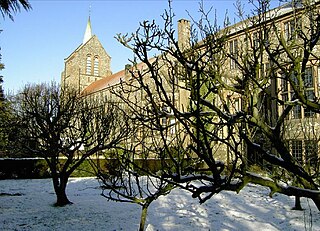
Greyfriars is a Roman Catholic friary and parish located in East Oxford, which until 2008 was also a permanent private hall of the University of Oxford. Situated on the Iffley Road in East Oxford, it was one of the smallest constituent halls of the university. Its status as a permanent private hall (PPH) derived from the fact that it was governed by an outside institution, rather than by the fellows of the University as a constituent college is.
Angelo da Clareno, also known as Angelo Clareno, was the founder and leader of one of the groups of Fraticelli in the early 14th century.
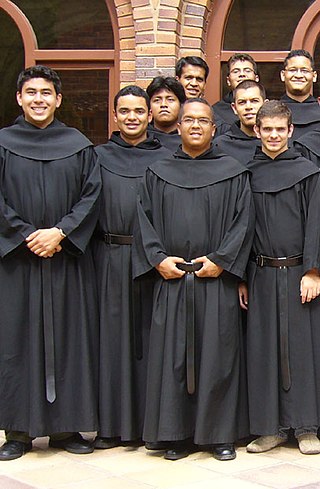
A friar is a member of one of the mendicant orders of the Roman Catholic church. There are also friars outside of the Roman Catholic church, such as within the Anglican Communion. The term, first used in the 12th or 13th century, distinguishes the mendicants' itinerant apostolic character, exercised broadly under the jurisdiction of a superior general, from the older monastic orders' allegiance to a single monastery formalized by their vow of stability. A friar may be in holy orders or be a non-ordained brother. The most significant orders of friars are the Dominicans, Franciscans, Augustinians, and Carmelites.

Mendicant orders are, primarily, certain Roman Catholic religious orders that have adopted for their male members a lifestyle of poverty, traveling, and living in urban areas for purposes of preaching, evangelization, and ministry, especially to the poor. At their foundation these orders rejected the previously established monastic model. This model prescribed living in one stable, isolated community where members worked at a trade and owned property in common, including land, buildings and other wealth. By contrast, the mendicants avoided owning property at all, did not work at a trade, and embraced a poor, often itinerant lifestyle. They depended for their survival on the goodwill of the people to whom they preached. The members of these orders are not called monks but friars.

Francisco Solano y Jiménez was a Spanish friar and missionary in South America, belonging to the Order of Friars Minor, and is honored as a saint in the Roman Catholic Church.

Lawrence of Brindisi, OFM Cap., born Giulio Cesare Russo, was an Neapolitan Catholic priest, theologian and member of the Order of Friars Minor Capuchin. An accomplished linguist, in addition to his native Italian, Lawrence could read and speak Latin, Hebrew, Greek, German, Czech, Spanish, and French fluently. Lawrence was ordained a priest at the age of 23. Lawrence was beatified on 1 June 1783 and canonized as a saint on 8 December 1881.

The Order of Friars Minor Conventual (O.F.M.Conv.) is a male religious fraternity in the Catholic Church and a branch of the Franciscan Order. Conventual Franciscan Friars are identified by the affix O.F.M.Conv. after their names. They are also known as Conventual Franciscans or Minorites.
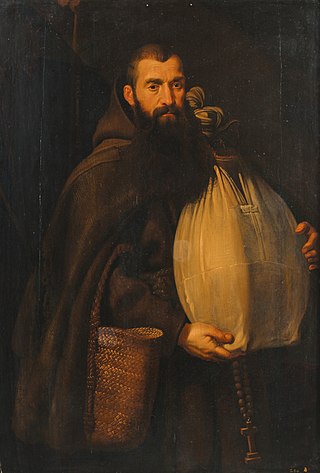
Felix of Cantalice, OFMCap was an Italian Capuchin friar of the 16th century. Canonized by Pope Clement XI in 1712, he was the first Capuchin friar to be named a saint. He worked as a shepherd and farmhand until he was twenty-eight. His task as a Capuchin was to beg alms for the friars. So successful was he that Brother Felix was able to extend his collections to assist the poor.
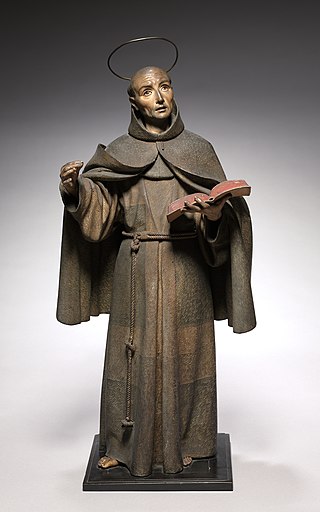
Peter of Alcántara, OFM was a Spanish Franciscan friar who was canonized in 1669.
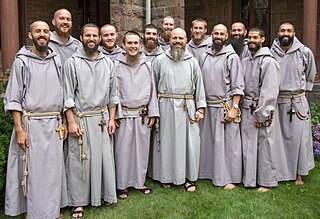
The Franciscan Friars of the Renewal is a Catholic clerical religious congregation of Pontifical Right for men founded in 1987. It follows the Capuchin Franciscan tradition.
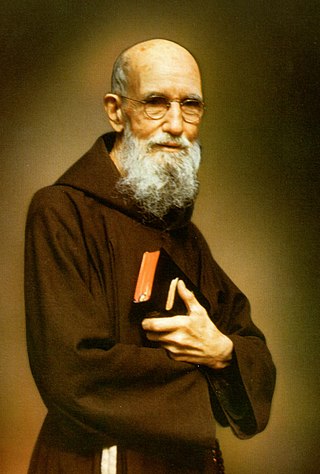
Solanus Casey, OFM Cap, born Bernard Francis Casey, was an American religious priest of the Order of Friars Minor Capuchin. He was known during his lifetime as a healer for his great faith and his abilities as a spiritual counselor, but especially for his great attention to the sick, for whom he celebrated special Masses. The friar was much sought-after and revered, especially in Detroit, where he resided. He was also a noted lover of the violin, a trait he shared with his eponym, Saint Francis Solanus.
The Third Order of Saint Francis is a third order in the Franciscan tradition of Christianity, founded by the medieval Italian Catholic friar Francis of Assisi.

The Capuchin Poor Clares is a Catholic religious order of Pontifical Right for women founded in Naples, Italy, in 1538, by Blessed Maria Lorenza Longo. The order still exists and it now has communities in the United States. Members are referred to as Capuchinesses.
Matteo Serafini was the co-founder and first Superior-General of the Order of Friars Minor Capuchins, the principal branch of the Franciscans issued from the Reform of the Observance.
Custos means a religious superior or an official in the Franciscan Order. The precise meaning has differed over time, and among the Friars Minor, Conventuals, and Capuchins.

John Forest was an English Franciscan friar and martyr. Confessor to Queen Catherine of Aragon, Forest was burned to death at Smithfield for heresy, in that he refused to acknowledge the King as head of the church.

Benedict Joseph Groeschel, C.F.R. was an American Franciscan friar, Catholic priest, retreat master, author, psychologist, activist, and television host. He hosted the television talk program Sunday Night Prime on the Eternal Word Television Network, as well as several serial religious specials.
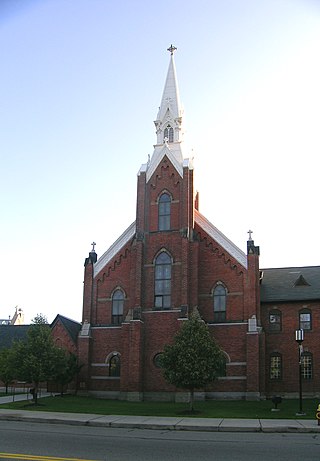
The St. Bonaventure Monastery is a complex of religious buildings, built for the Order of Friars Minor Capuchin, located at 1740 Mt. Elliott Avenue in Detroit, Michigan. It was listed on the National Register of Historic Places in 1982.

The Order of Friars Minor is a mendicant Catholic religious order, founded in 1209 by Francis of Assisi. The order adheres to the teachings and spiritual disciplines of the founder and of his main associates and followers, such as Clare of Assisi, Anthony of Padua, and Elizabeth of Hungary, among many others. The Order of Friars Minor is the largest of the contemporary First Orders within the Franciscan movement.
References
Citations
- 1 2 3 4 5 6 "Order of Friars Minor Capuchin (Institute of Consecrated Life - Men) [Catholic-Hierarchy]".
- 1 2 3 4 5 Chisholm, Hugh, ed. (1911). . Encyclopædia Britannica (11th ed.). Cambridge University Press.
- ↑ Fragaszy; et al. (2004). The complete capuchin : the biology of the genus Cebus. Cambridge University Press. p. 5. ISBN 978-0-521-66116-4. OCLC 55875701.
- ↑ Capuchin monkeys also have "hoodlike tufts of hair" on their heads. Entry, "capuchin" in The American Heritage Dictionary of the English Language (1976), Boston: Houghton Mifflin.
- ↑ "The Culture of Italian Coffee". Archived from the original on 2011-03-05. Retrieved 2011-01-18.
- ↑ The crime of crimes: demonology and politics in France, 1560–1620, Jonathan L. Pearl, Wilfrid Laurier Univ. Press, 1999 ISBN 0-88920-296-6, ISBN 978-0-88920-296-2
- ↑ Capuchin Crypt Placard Archived 2008-10-22 at the Wayback Machine , Crypto Archeologico: Capuchin Crypts
- ↑ statistical data from 'Analecta Ordinis Fratrum Minorum Capuccinorum, Roma
- 1 2 "Diocese of Bettiah". Union of Catholic Asian News . Retrieved 15 November 2020.
- ↑ "FATHER HAAS'S LABORS IN WISCONSIN; The Introducer of the Capuchin Order in the United States" (PDF). The New York Times. 28 June 1895.
- ↑ "Capuchin Franciscan Province of St Joseph". capuchins.org. Retrieved 2016-06-17.
- ↑ "Capuchin Franciscans, Province of St Conrad". capuchins.org. Retrieved 2016-06-17.
- ↑ "Capuchin Franciscans, Western America Province". capuchins.org. Retrieved 2016-06-17.
- ↑ "The Capuchin Poor Clares" . Retrieved 2016-06-17.
- 1 2 3 "Saints and Blesseds". www.ofmcap.org. Retrieved Jan 11, 2023.
- 1 2 3 ""Liturgical calendar", Capuchin Franciscan Friars, Province of the Stigmata" . Retrieved Jan 11, 2023.
- 1 2 3 "Capuchins". Capuchins. Retrieved Jan 11, 2023.
- 1 2 3 "Capuchin Saints, Capuchin Franciscans, St. Conrad Province". capuchins.org. Retrieved Jan 11, 2023.
- ↑ "Bl. Jacques Ghazir Haddad (1875-1954) - Biography".
- ↑ "Poor Clares". www.capuchinpoorclares.org. Retrieved 2020-05-04.
Sources
- There does not appear to be any modern general history of the Capuchin order as a whole, though there are histories of various provinces and of the foreign missions. The references to this literature can be found in the article "Kapuzinerorden" in Wetzer und Welte, Kirchenlexicon (2nd ed.), a general sketch on the subject.
- Shorter sketches, with the needful references, are given in Max Heimbucher, Orden und Kongregationen (1896), i. §4 and in Herzog-Hauck, Realencyklopedie (3rd ed.), art. "Kapuziner."
- Helyot's Hist. des ordres religieux (1792), vii. c. 24 and c. 27, gives an account of the Capuchins up to the end of the 17th century.
External links
- Ordo Fratrum Minorum Capuccinorum, official website of international Religious Order
- Capuchins in Canada – Mary, Mother of the Good Shepherd Province, official website
- Capuchins of Ireland – Province of St. Patrick and St. Francis, official website
- Capuchins in Great Britain – Province of Our Lady Assumed Into Heaven and St. Lawrence of Brindisi
- Capuchin Franciscan Order – Our Lady of Angels Province, official website of Capuchin Franciscan Order in Western America
- The Capuchin-Franciscan Province of St. Joseph (Mid-West USA), official website
- Province of St. Joseph, official website
- Province of St. Conrad, official website
- Province of the Sacred Stigmata of St. Francis (New Jersey and Southeastern US), official website
- The Capuchin-Franciscans of the Province of Saint Augustine, official website
 This article incorporates text from a publication now in the public domain : Herbermann, Charles, ed. (1913). "Capuchin Friars Minor". Catholic Encyclopedia . New York: Robert Appleton Company.
This article incorporates text from a publication now in the public domain : Herbermann, Charles, ed. (1913). "Capuchin Friars Minor". Catholic Encyclopedia . New York: Robert Appleton Company.
Text is available under the CC BY-SA 4.0 license; additional terms may apply.
Images, videos and audio are available under their respective licenses.
